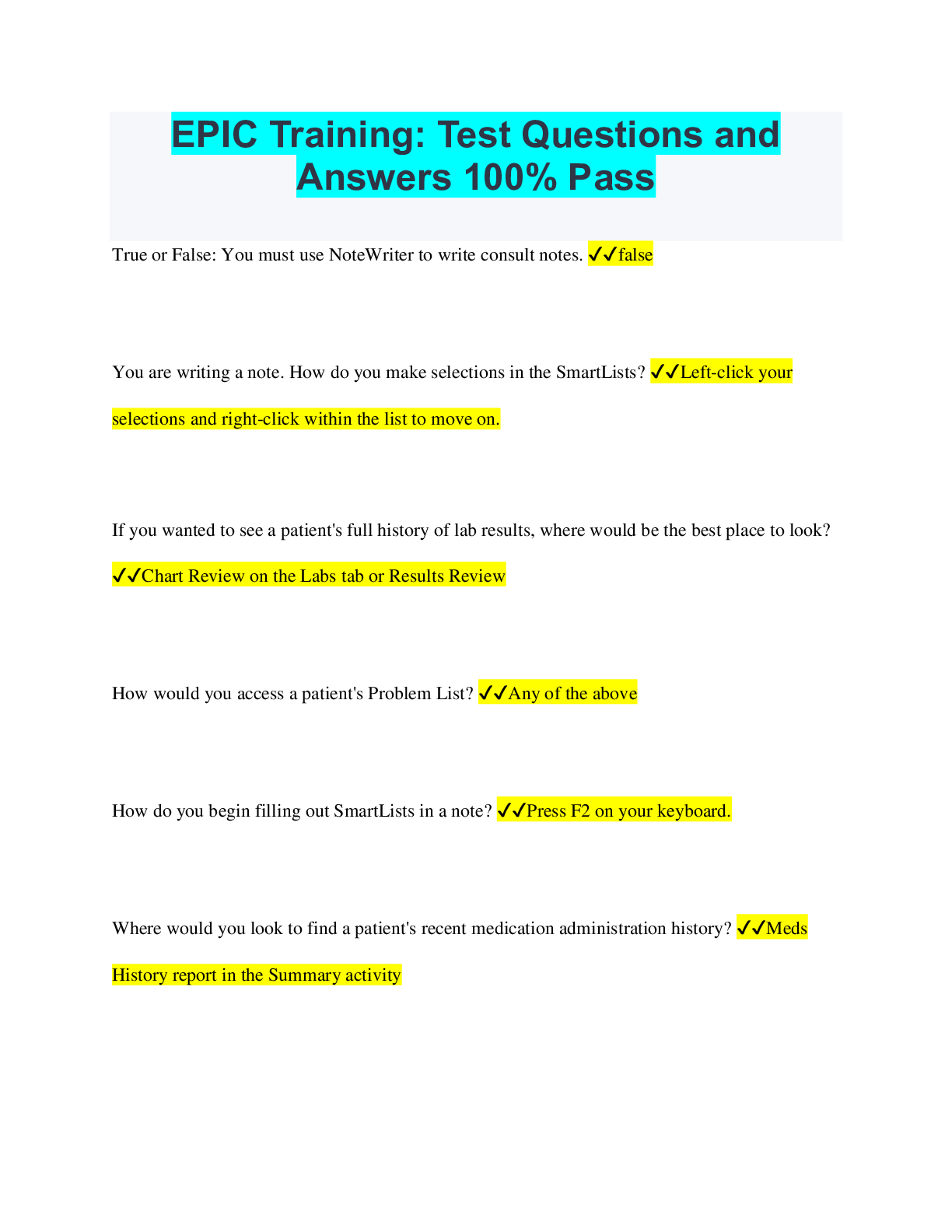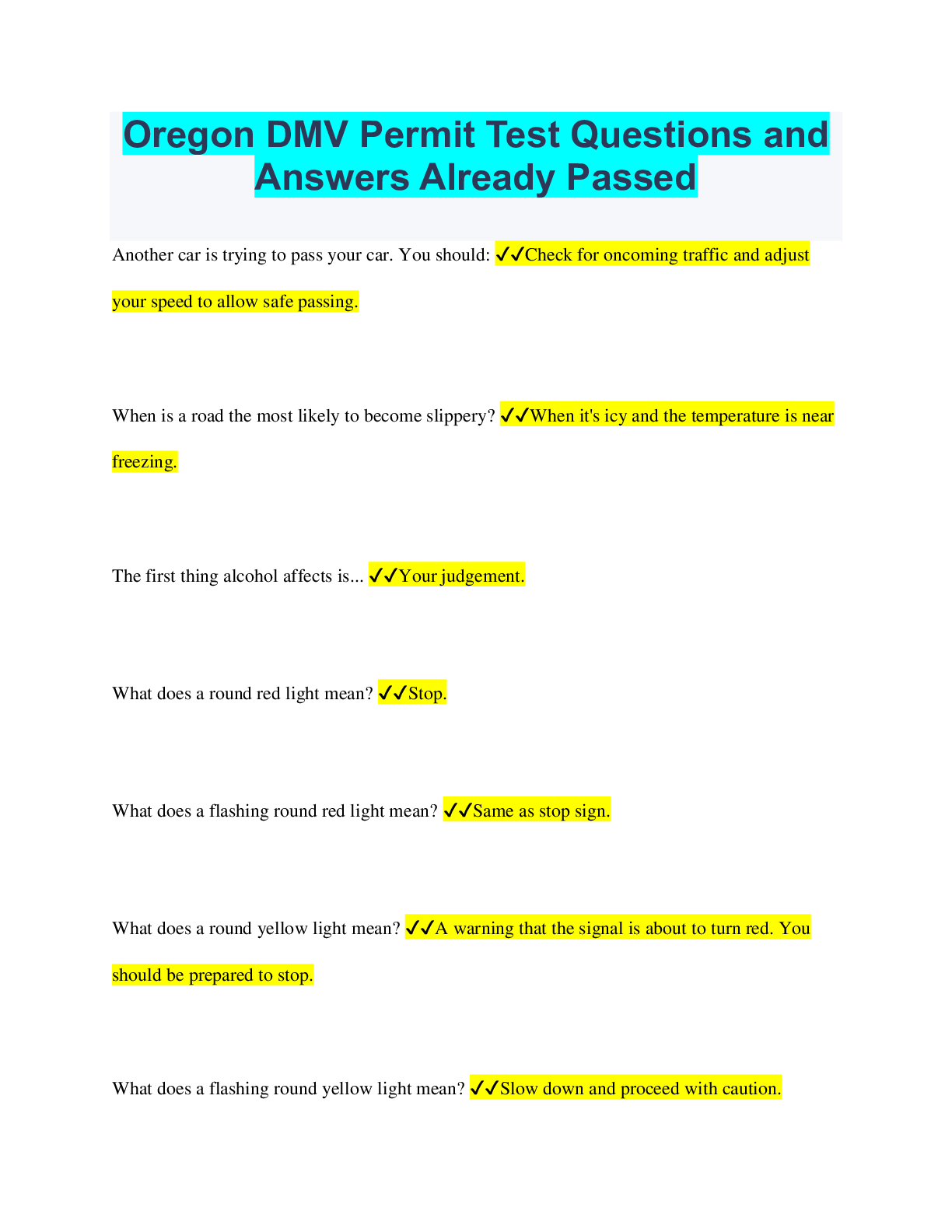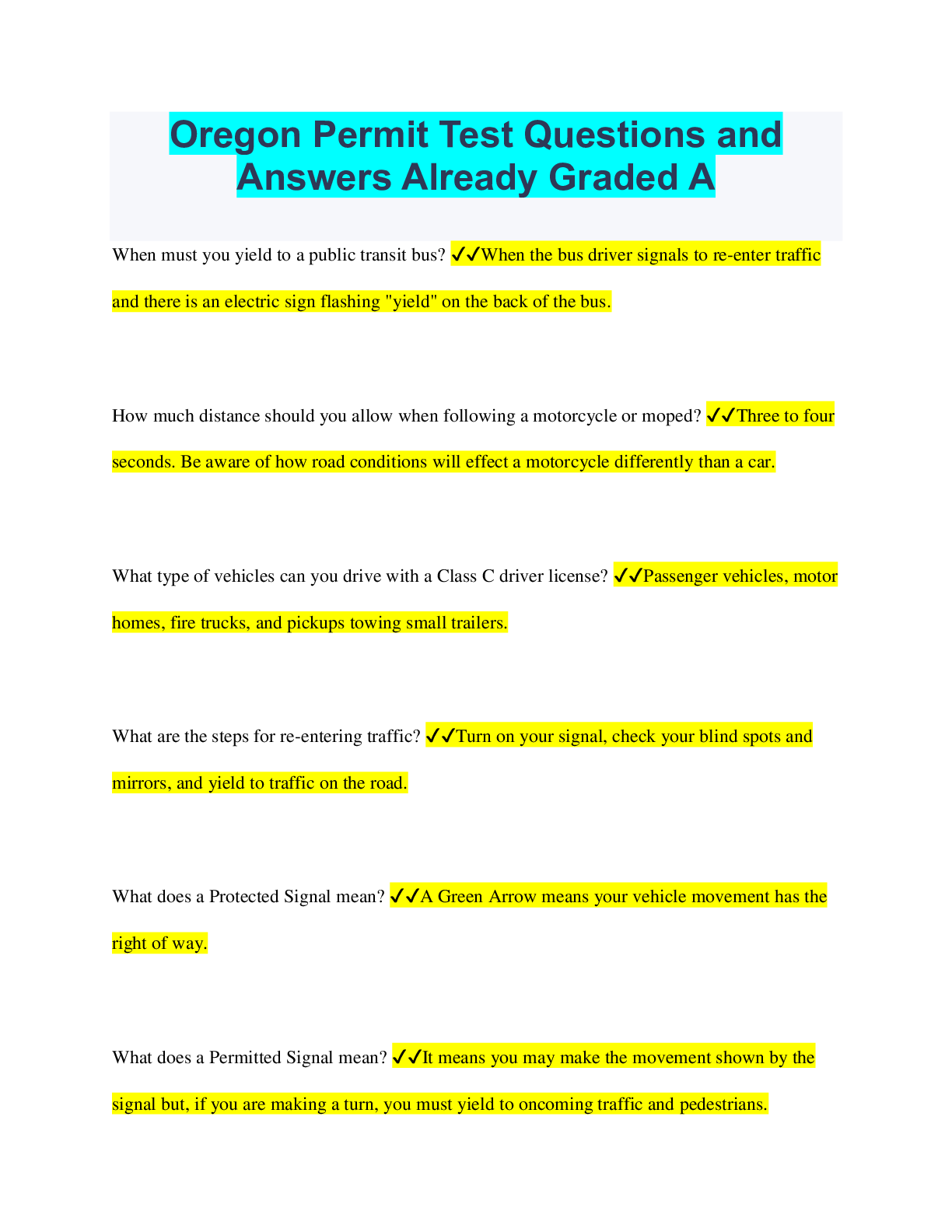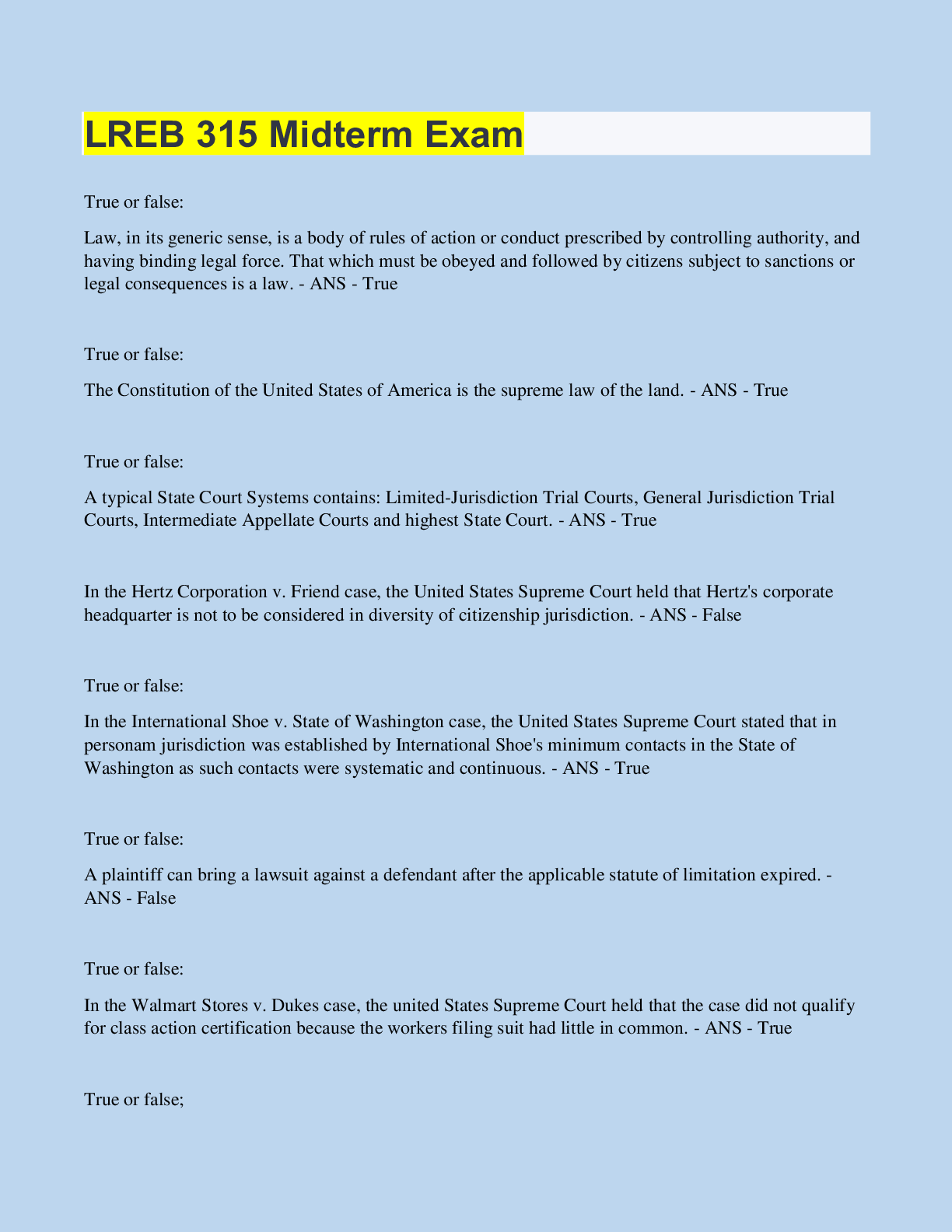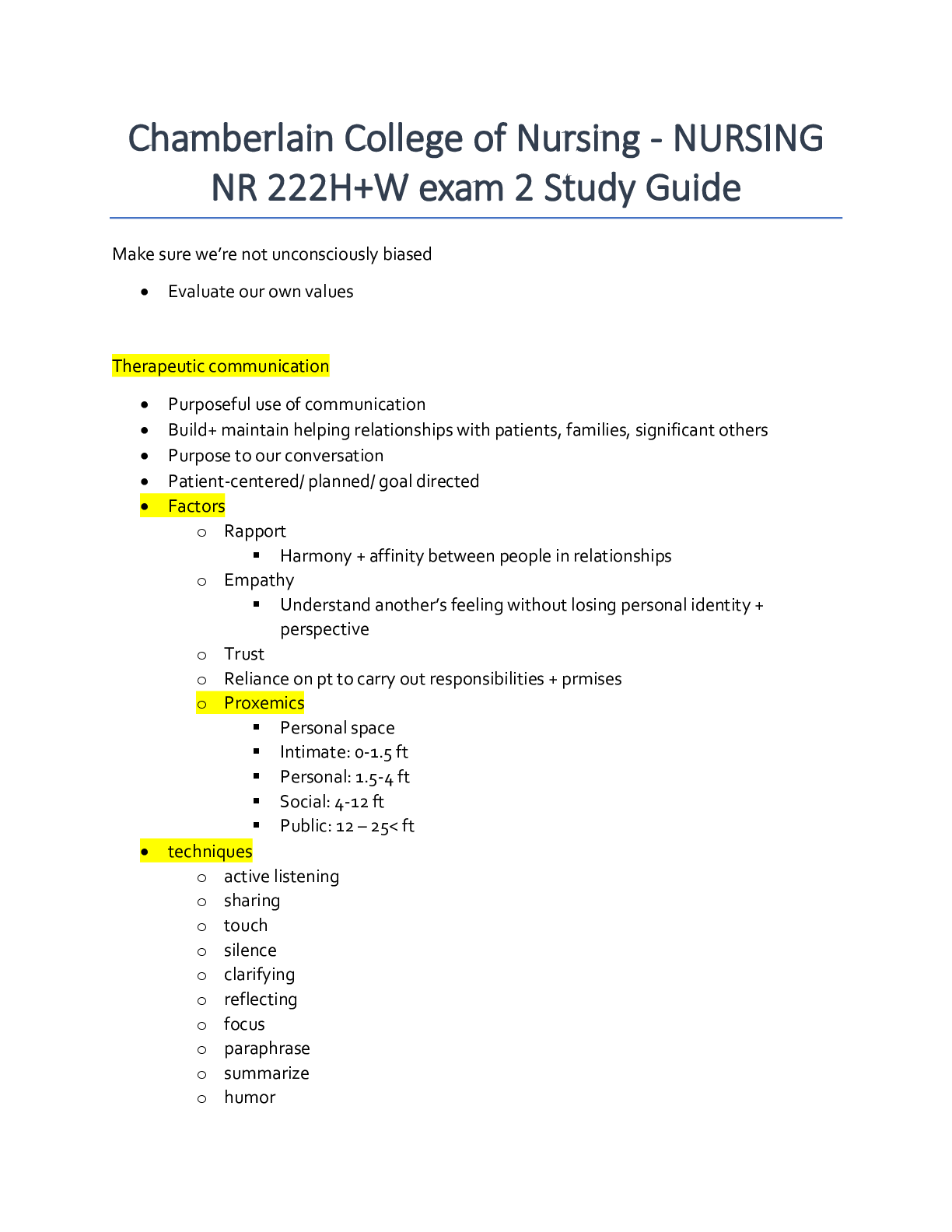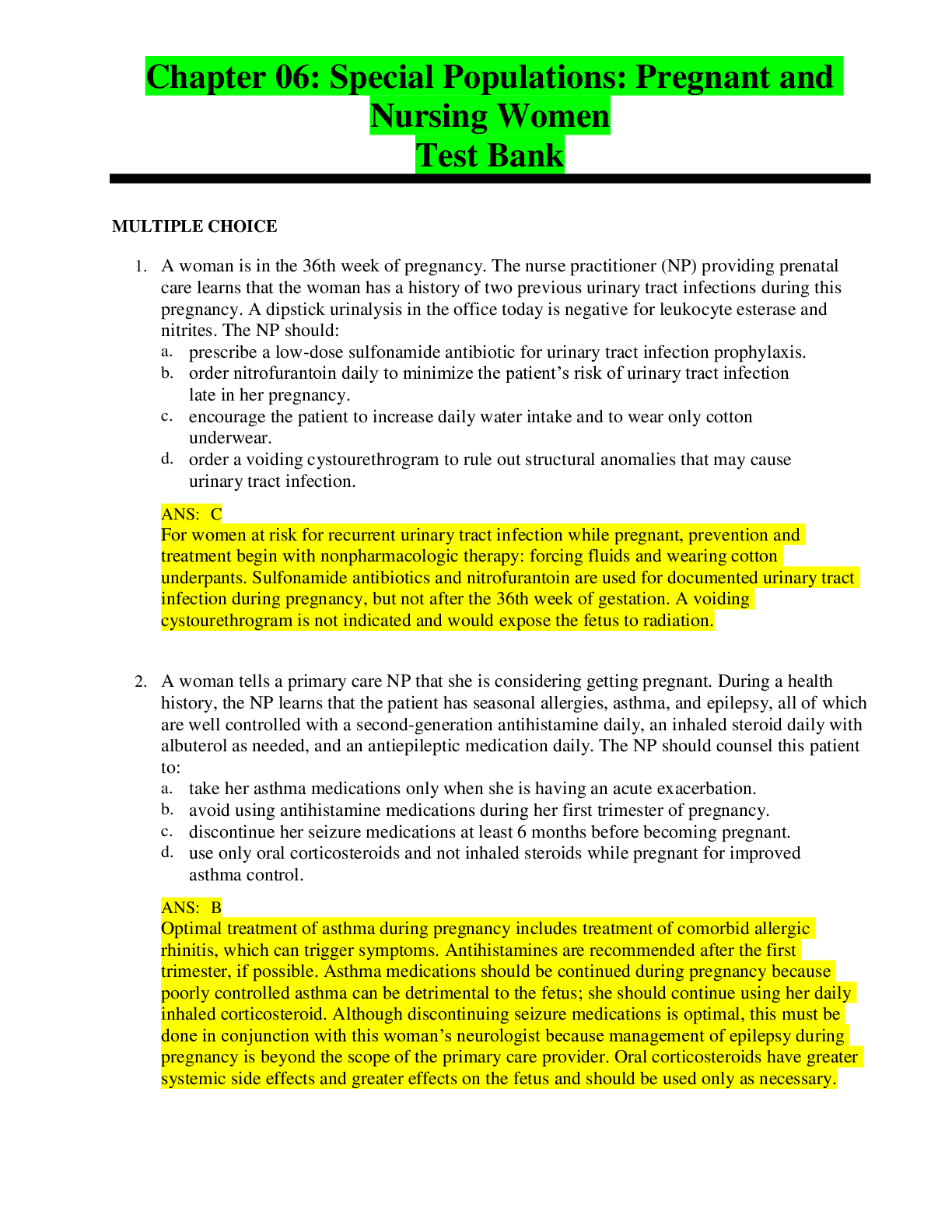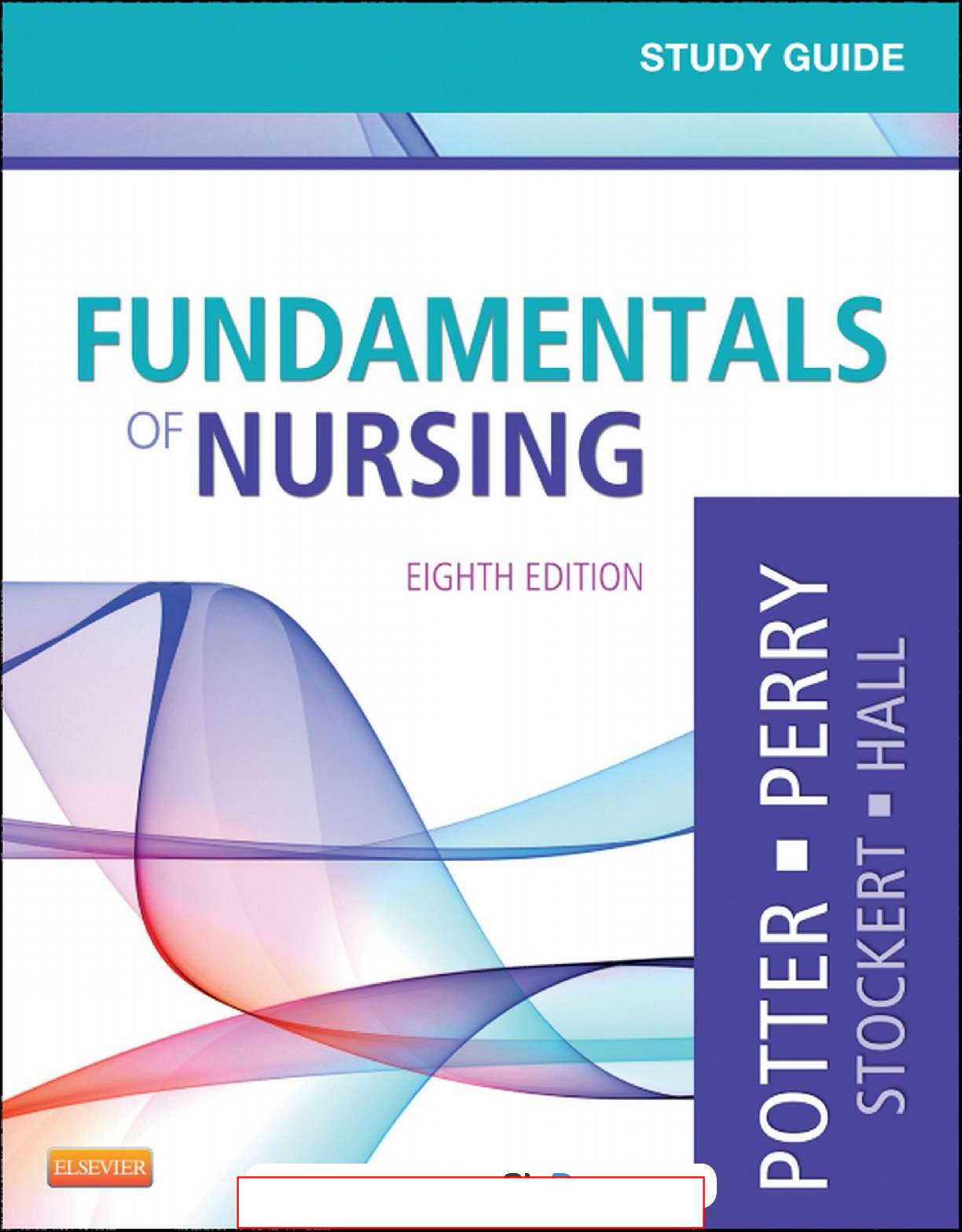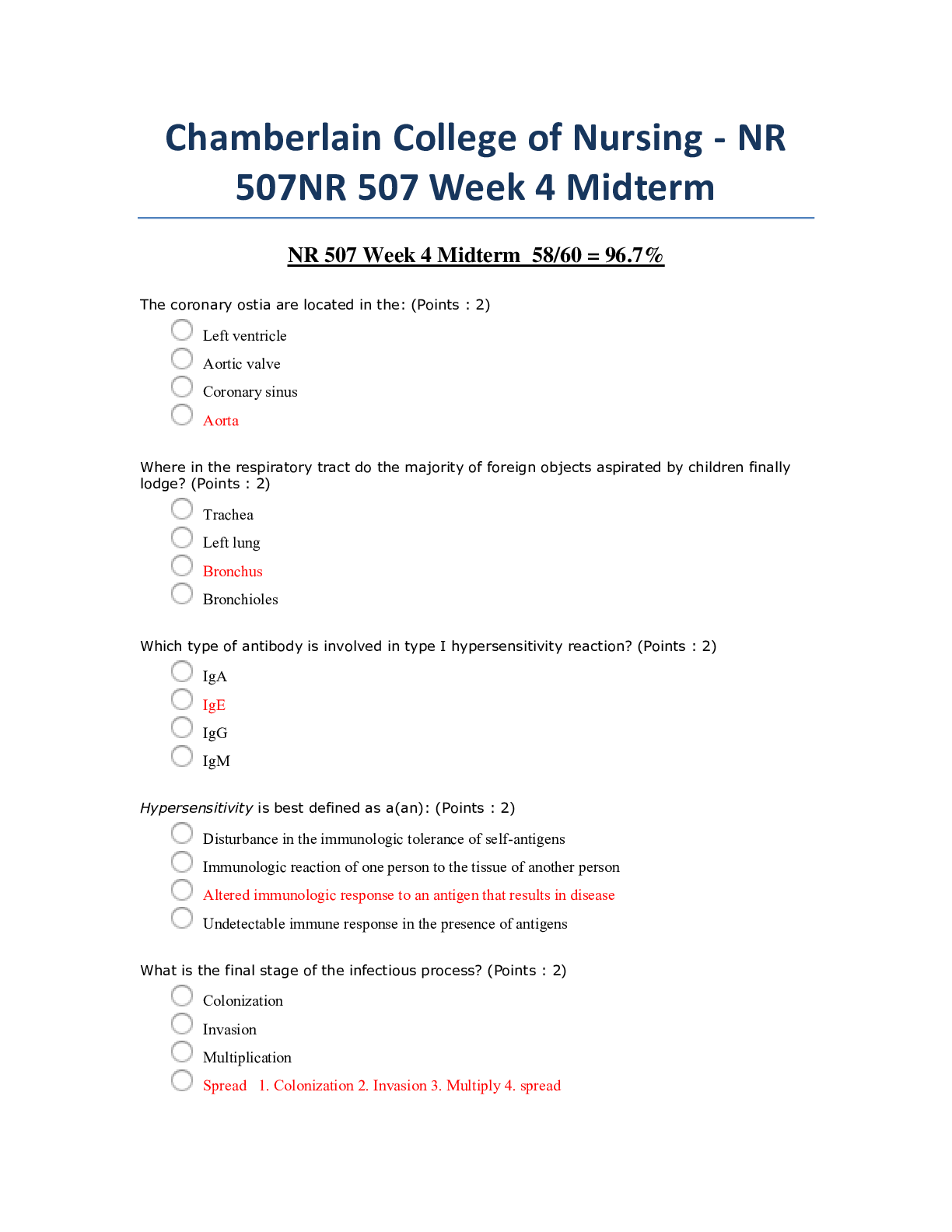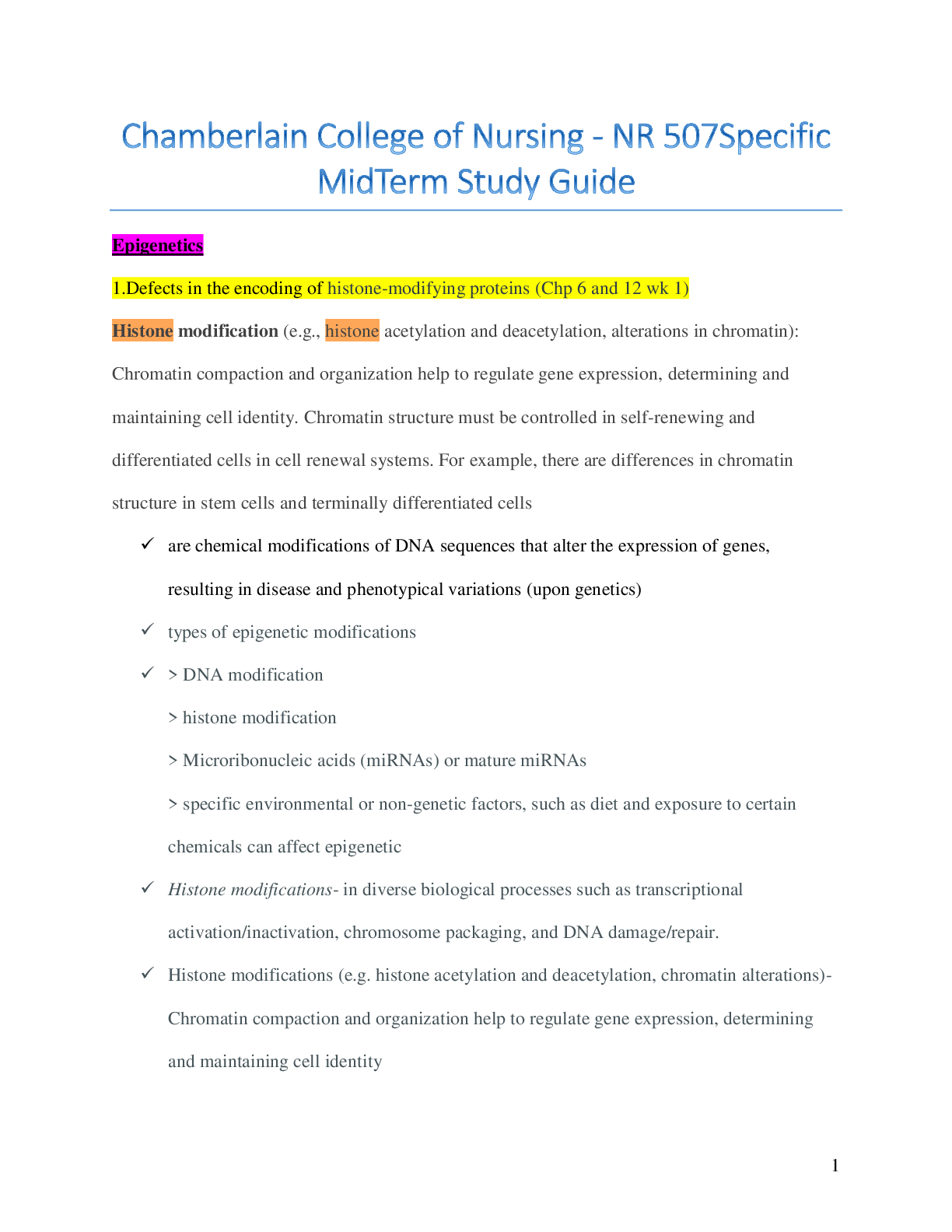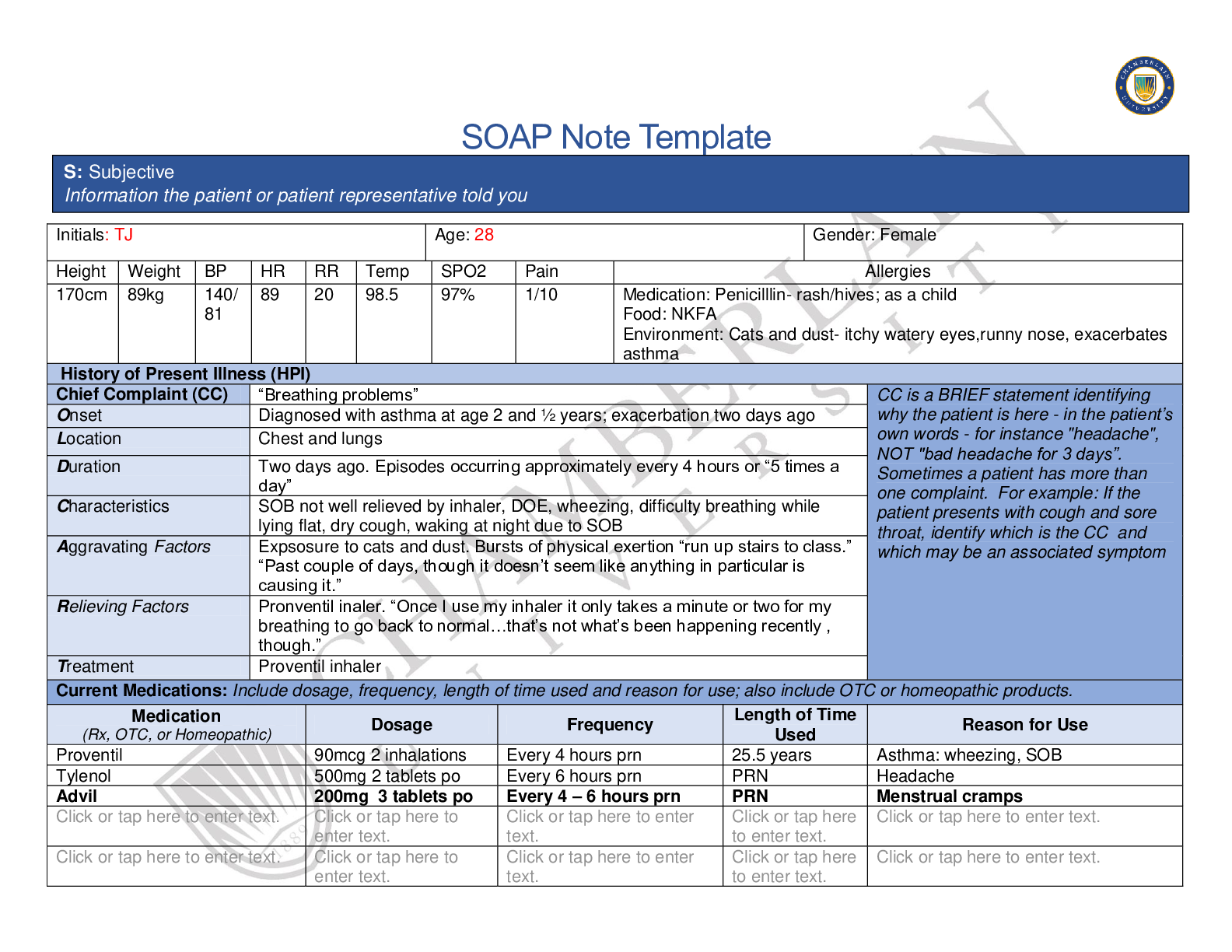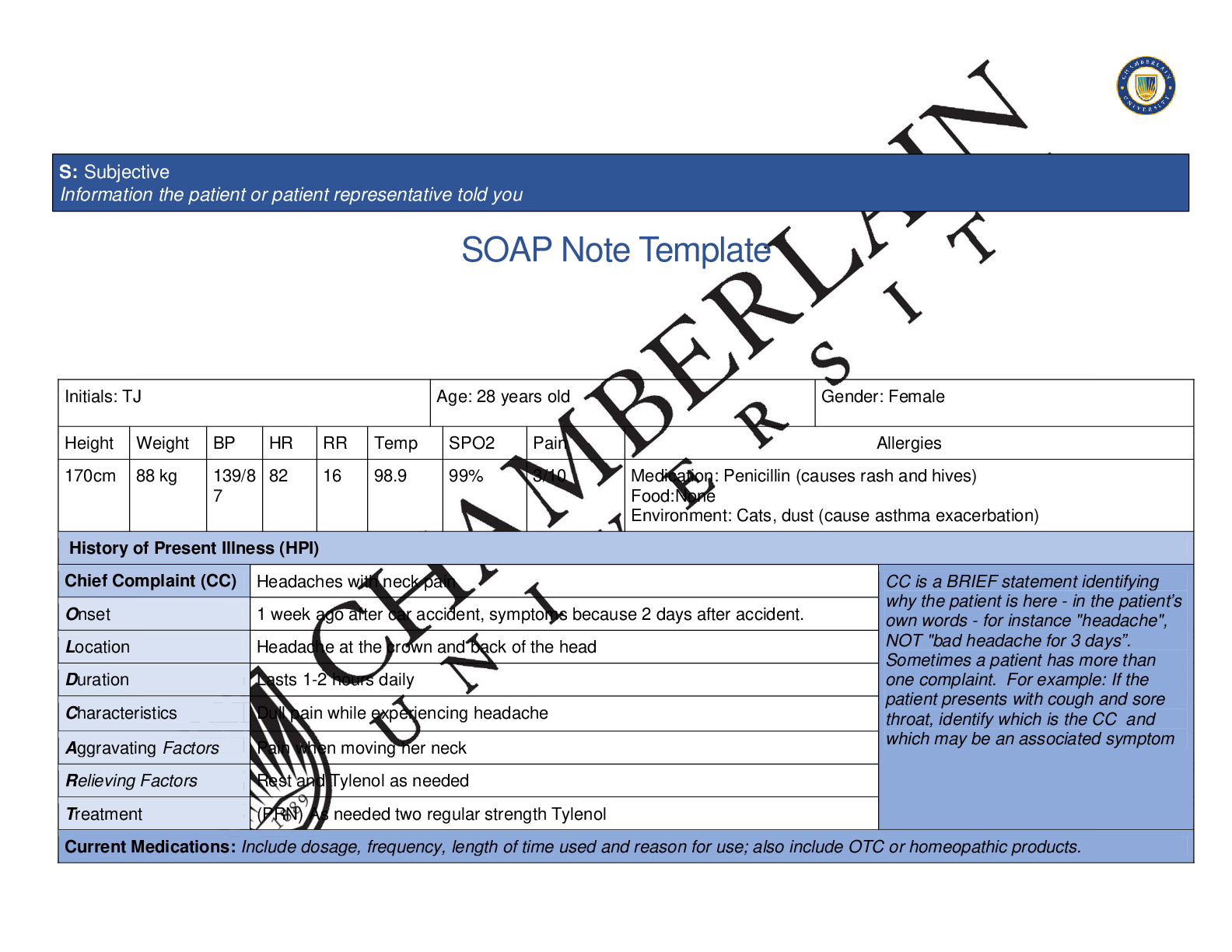*NURSING > QUESTIONS & ANSWERS > Chamberlain College of Nursing - NR 507 > Patho Midterm week 4 exam - Latest 2019; Verified Answers (All)
Chamberlain College of Nursing - NR 507 > Patho Midterm week 4 exam - Latest 2019; Verified Answers with Instructor's Explanations.
Document Content and Description Below
1. Question : Hemolytic disease of the newborn (HDN) can occur if the mother: Student Answer: Is Rh-positive and the fetus is Rh-negative Is Rh-negative and the fetus is Rh-positive Has t... ype A blood and the fetus has type O Has type AB blood and the fetus has type B Instructor Explanation: HDN can occur only if antigens on fetal erythrocytes differ from antigens on maternal erythrocytes. Maternal-fetal incompatibility exists only if the mother and fetus differ in ABO blood type or if the fetus is Rh-positive and the mother is Rh-negative. This erythrocyte incompatibility does not exist in any of the other options. Points Received: 2 of 2 Comments: Question 2. Question : Examination of the throat in a child demonstrating signs and symptoms of acute epiglottitis may contribute to which life- threatening complication? Student Answer: Retropharyngeal abscess Laryngospasms Rupturing of the tonsils Gagging induced aspiration Instructor Explanation: Examination of the throat may trigger laryngospasm and cause respiratory collapse. Death may occur in a few hours. This selection is the only option that accurately identifies the life-threatening complication that can result from -589875941 MultipleChoice 68 True 0 -589875941 MultipleChoice 68 an examination of the throat of a child who demonstrates the signs and symptoms of acute epiglottitis. Points Received: 2 of 2 Comments: Question 3. Question : If the sinoatrial (SA) node fails, then at what rate (depolarizations per minute) can the atrioventricular (AV) node depolarize? Student Answer: 60 to 70 40 to 60 30 to 40 10 to 20 Instructor Explanation: If the SA node is damaged, then the AV node will become the heart’s pacemaker at a rate of approximately 40 to 60 spontaneous depolarizations per minute. Points Received: 2 of 2 Comments: Question 4. Question : What is the ratio of coronary capillaries to cardiac muscle cells? Student Answer: 1:1 (one capillary per one muscle cell) 1:2 (one capillary per two muscle cells) 1:4 (one capillary per four muscle cells) -589875940 MultipleChoice 87 True 0 -589875940 MultipleChoice 87 -589875939 MultipleChoice 75 True 0 -589875939 MultipleChoice 75 1:10 (one capillary per ten muscle cells) Instructor Explanation: The heart has an extensive capillary network, with approximately 3300 capillaries per square millimeter (ca/mm2 ) or approximately one capillary per one muscle cell (muscle fiber). Points Received: 2 of 2 Comments: Question 5. Question : Which cytokines initiate the production of corticotropin-releasing hormone (CRH)? Student Answer: IL–1 and IL-6 IL-2 and TNF- IFN and IL-12 TNF-ß and IL-4 Instructor Explanation: Although a number of stress factors initiate the production of CRH, of the options available, only high levels of IL-1 and IL-6 initiate such a response. Points Received: 2 of 2 Comments: Question 6. Question : What process allows the kidney to respond to an increase in workload? Student Answer: Glomerular filtration Secretion of 1,25-dihydroxyvitamin D3 -589875938 MultipleChoice 73 True 0 -589875938 MultipleChoice 73 -589875937 MultipleChoice 21 True 0 -589875937 MultipleChoice 21 Increased heart rate Compensatory hypertrophy Instructor Explanation: Compensatory hypertrophy allows the kidney to respond to an increase in workload throughout life. The remaining options are not relevant to accommodating an increased workload. Points Received: 2 of 2 Comments: Question 7. Question : Which type of antibody is involved in type I hypersensitivity reaction? Student Answer: IgA IgE IgG IgM Instructor Explanation: Type I reactions are only mediated by antigen-specific IgE and the products of tissue mast cells (see Figure 9-1). Points Received: 2 of 2 Comments: Question 8. Question : Causes of hyperkalemia include: Student Answer: Hyperparathyroidism and malnutrition -589875936 MultipleChoice 108 True 0 -589875936 MultipleChoice 108 -589875935 MultipleChoice 9 True 0 -589875935 MultipleChoice 9 Vomiting and diarrhea Renal failure and Addison disease Hyperaldosteronism and Cushing disease Instructor Explanation: Hyperkalemia should be investigated when a history of renal disease, massive trauma, insulin deficiency, Addison disease, use of potassium salt substitutes, or metabolic acidosis exists. The other options are not known to be causes of hyperkalemia. Points Received: 2 of 2 Comments: Question 9. Question : What is the first stage in the infectious process? Student Answer: Invasion Colonization Spread Multiplication Instructor Explanation: From the perspective of the microorganisms that cause disease, the infectious process undergoes four separate stages of progression: (1) colonization, (2) invasion, (3) multiplication, and (4) spread. Points Received: 2 of 2 Comments: Question 10 . Question : Which statement is true concerning the IgM? -589875934 MultipleChoice 36 True 0 -589875934 MultipleChoice 36 -589875933 MultipleChoice 7 True 0 -589875933 MultipleChoice 7 Student Answer: IgM is the first antibody produced during the initial response to an antigen. IgM mediates many common allergic responses. IgM is the most abundant class of immunoglobulins. IgM is capable of crossing the human placenta. Instructor Explanation: Typically, IgM is produced first (primary immune response), followed by IgG against the same antigen. The other options are not true statements regarding IgM. Points Received: 2 of 2 Comments: Question 11 . Question : An infant has a loud, harsh, holosystolic murmur and systolic thrill that can be detected at the left lower sternal border that radiates to the neck. These clinical findings are consistent with which congenital heart defect? Student Answer: Atrial septal defect (ASD) Ventricular septal defect (VSD) Patent ductus arteriosus (PDA) Atrioventricular canal (AVC) defect Instructor Explanation: On physical examination, a loud, harsh, holosystolic murmur and systolic thrill can be detected at the left lower sternal border. The intensity of the murmur reflects the pressure gradient across the VSD. An apical diastolic rumble may be present with a moderate-to-large defect, reflecting increased flow across the mitral valve. The presentations of the other congenital heart defects are not consistent with the described symptoms. [Show More]
Last updated: 2 years ago
Preview 1 out of 33 pages
 (1).png)
Buy this document to get the full access instantly
Instant Download Access after purchase
Buy NowInstant download
We Accept:

Reviews( 0 )
$14.00
Can't find what you want? Try our AI powered Search
Document information
Connected school, study & course
About the document
Uploaded On
Sep 28, 2021
Number of pages
33
Written in
Additional information
This document has been written for:
Uploaded
Sep 28, 2021
Downloads
0
Views
126

.png)


